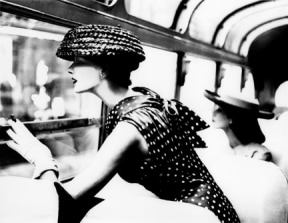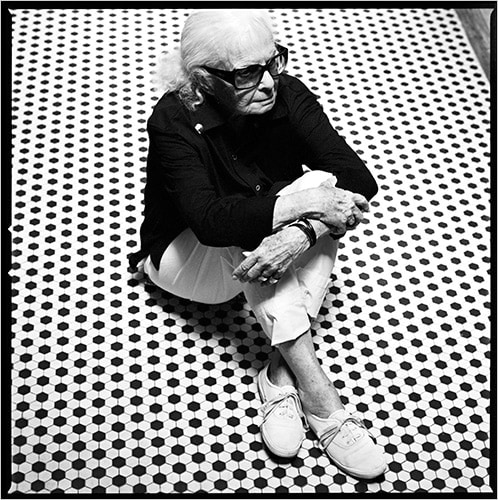

In the early 1970s Lillian Bassman, among the most important fashion photographers of the 20th century, made the decision to dispose of her career, quite literally. Artists do this all the time without the intent — giving themselves over to excess, retreating to ashrams — but Ms. Bassman’s approach was aggressive and determined. Disillusioned by the costuming of the late 1960s, she had had enough of fashion and expressed her disdain by destroying decades’ worth of negatives and placing others in a trash bag in the coal room of her Upper East Side carriage house. Her era of furtive eroticism was over, and there was no point in scrapbooking it.
Years later Ms. Bassman, who is 92, relented and retrieved her discarded images, seeking creative ways to reprint them. Some of these pictures will be on view at a new show at KMR Arts in Washington Depot, Conn. (which begins Saturday and runs through Sept. 5), juxtaposed with an anatomically resonant series on sidewalk cracks that she produced in the ’70s. The exhibition serves as a preamble to a moment of renewed interest in Ms. Bassman’s career; this fall Abrams will publish a book of her work, “Lillian Bassman: Women,” which will accompany a show at the Staley-Wise Gallery. And in November the Deichtorhallen museum in Hamburg, Germany, will mount a retrospective of her photography, along with that of her husband, Paul Himmel, who died in February.
Ms. Bassman took her most significant pictures from the late ’40s to the early ’60s; most were published in Harper’s Bazaar under the stewardship of the magazine’s influential art director Alexey Brodovitch and belong distinctly to the era of “Mad Men” New York. The clothes have a structured beauty; the gloves are mandatory; the necks are long. Elegant men with cigarettes between their fingers occasionally enter the frame, encountering women who appear utterly indifferent to their attention. The perversions of inequality are absent; what appears instead is the glamour of a protracted cultural moment in which women were free from any expectation of sexual pursuit. The power of Ms. Bassman’s photographs is the power of a woman who is never moved to make a call.
At the same time that she was turning out editorial work Ms. Bassman was having a considerable impact on advertising, photographing lingerie for Warner’s and other purveyors in a manner that abandoned the pharmaceutical aesthetic that then prevailed in the industry’s marketing. (These pictures form a large part of the show at KMR.) In place of heavy-set women constraining themselves in what was essentially equipment, Ms. Bassman deployed immeasurably lithe models, conveying a world in which women seemed to linger in the pleasures of their own sensuality. In her eye the undergarment emerges as a wardrobe unto itself, as if anything else in a woman’s closet were simply an imposition.
It is easy to see why Ms. Bassman would have found little appeal in the uniform of the sexual revolution, first the childlike clothes of Mod style and then the hippie’s caftans, which seemed intended to counter the mass libidinal energy that had been the whole point. Hers was a world of adult sexuality that wasn’t ranted about. And the new breed of models coming of age in the late ’60s and ’70s unnerved her as well.
“I got sick of them,” she said recently in the living room in her house in the East 80s. “They were becoming superstars. They were not my kind of models. They were dictating rather than taking direction.” Ms. Bassman did not need a prepackaged sexual freedom movement; she’d lived her own version years earlier. Born in 1917, the child of Russian émigrés who moved from New Haven to Brooklyn to Greenwich Village, she was given ample rein over her romantic life at an early age.
Ms. Bassman first met Mr. Himmel splashing about at Coney Island; she was 6, and he was 9. When she saw him again a several years later, she fell incurably in love, and after a brief resistance her father permitted her to live with her suitor when she was 15. The couple divided their week between her family’s apartment on 13th Street and his parents’ place two blocks away. They married when Ms. Bassman was 25, and were together until Mr. Himmel’s death in February at 94, their relationship having spanned 77 years. “He never bored me,” Ms. Bassman explained.
As teenagers they spent every weekend at the Metropolitan Museum of Art, where Ms. Bassman was drawn to the attenuated limbs of El Greco. She skipped a good deal of school, reading whatever Mr. Himmel and his friends were picking up when he was at City College. “When I’d get up in class and talk about Aldous Huxley, the teachers were astounded,” she said. “I’d hoodwinked everyone into thinking I knew something when I didn’t know anything.”
By the ’40s Ms. Bassman was working as a graphic designer, but Richard Avedon, a friend of the couple’s, encouraged her in her career as a photographer. During a trip he made to Paris a few years after the war, he lent her both his studio and his assistant.
In the period dominated by Avedon and Irving Penn, Ms. Bassman was one of the few female photographers in the fashion business, and her work had a distinctly different cast from the outset, one less distancing. In most of the lingerie pictures, for example, the faces are averted or obscured, the result of the Ford agency’s insistence that its models not be identifiable in such provocative advertising.
The effect of this constraint is not cold anonymity but an unusual intimacy that leaves the images feeling almost entirely divorced from commodity, as if they were the visual entries in the personal journals of the women photographed.
Being a woman advantaged her, Ms. Bassman felt. “The models thought about this a lot,” she said. “It was a sexually very different thing when they worked with men. They felt a charge. They were posing for men. I caught them when they were relaxed, natural, and I spent a lot of time talking to them about their husbands, their lovers, their babies.”
Ms. Bassman’s interests were not conducive to having babies of her own however. She did not want a family, but her husband did, so she sought psychotherapy to resolve the issue. After six weeks, she said, she was inspired to motherhood. The couple had two children, Eric, a book editor, and Lizzie, a photographer and archivist of her parents’ work.
Mr. Himmel’s passion for photography predated his wife’s, whose introduction to the field began when she was assigned the job of washing his prints in the bathtub. He produced both fashion and documentary images; several of his pictures were included in Edward Steichen’s “Family of Man” exhibition at the Museum of Modern Art in 1955. But when he turned 57, he set his camera aside indefinitely — and then permanently — to return to school for a master’s degree in social work. For much of the rest of his life he worked first as psychiatric caregiver, treating schizophrenics in the city’s public hospitals and later seeing patients in private practice.
Ms. Bassman, though, ultimately returned to fashion photography, in the early ’90s, after her friend the painter Helen Frankenthaler, who had been renting studio space from her, found the bag of negatives that had been sequestered in the carriage house. Ms. Bassman, who had always been drawn to the manipulation of images, began altering the pictures, bleaching out backgrounds, for instance, to produce dramatic contrasts. As a result they now seem even more ethereal than they did in their original form, and immune to the beholder’s efforts to carbon-date them.
Five years ago, at 87, Ms. Bassman discovered the glories of Photoshop and so began a new chapter in digital photography. She works every day in her studio, toying and reconfiguring from about 11 in the morning until dinnertime, and claims a proud proficiency with her computer. It is a skill however that does not extend to the use of e-mail or Google. “I’m not interested,” she said, “in any of that.”